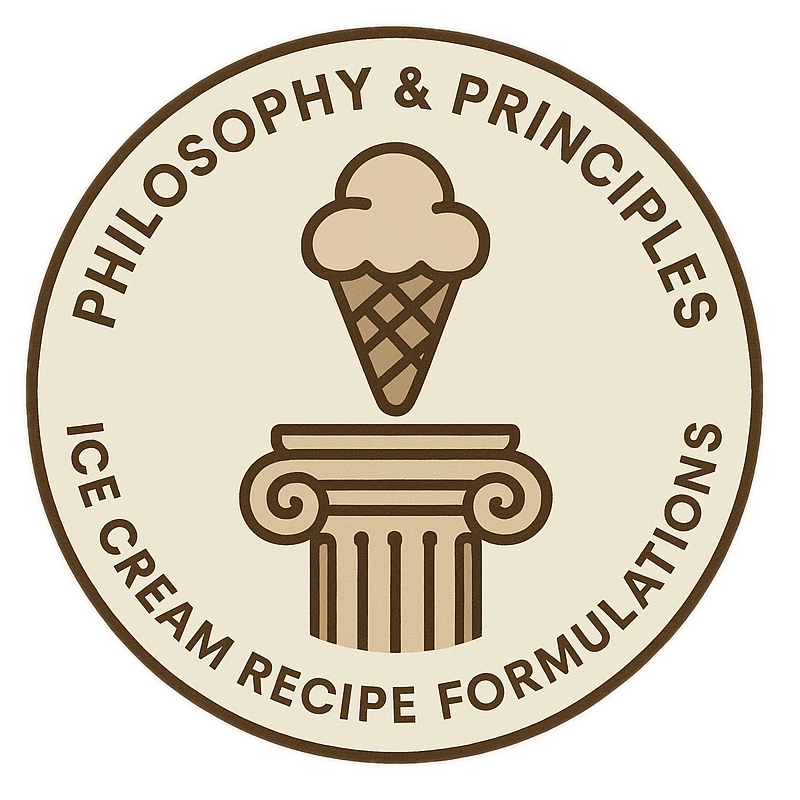Philosophy & Principles ¶
¶
The recipes here are designed to produce high-quality frozen desserts. They're calculated and optimized for flavor and texture, ensuring that the resulting ice creams are dense, creamy, non-melty, and free of ice crystals. Many of them are formulated to remain scoopable for days even after being put back into the freezer.
Below are the core components and principles underpinning the recipes.
1. Recipe Development and Calculation¶
The recipes are created using LibreOffice spreadsheets, which enable direct calculation of important ice cream metrics and nutritional information. A Python script then converts these spreadsheet exports into markdown files for the website. This systematic approach allows for precision in ingredient ratios and nutritional information.
2. Ingredient Amounts and Preparation Workflow¶
Ingredient amounts are specifically tailored for the 680ml (24oz) Creami Deluxe container size. For smaller models like the base Creami or the Swirl, recipes can be scaled down by using ⅔ (66%) of all ingredients.
The preparation workflow is streamlined, emphasizing the use of a kitchen scale to weigh both wet and dry ingredients. An immersion blender is crucial for quickly homogenizing the mixture and properly hydrating thickeners.
Some recipes also include "Mix" in their name, indicating partial recipes where dry ingredients can be pre-weighed and mixed in bulk for 5-10 tubs, increasing overall efficiency and making it easier to weigh small amounts of ingredients.
3. Key Ingredients and Their Functional Benefits¶
The recipes commonly feature a range of ingredients that contribute to both flavor and the desired frozen texture.
-
Sweeteners:
- Erythritol (E968): A non-caloric sugar alcohol, approximately 75% as sweet as sugar, which significantly lowers the freezing point of water (Freezing Point Depression Factor or FPDF of 2.8 compared to sugar). While it tends to crystallize in long-term frozen states, this can be mitigated by stabilizers and keeping its proportion below 8% of total weight.
- Xylitol: Another sugar alcohol, 100% as sweet as sugar (Potere Dolcificante or POD = 100%), with an FPDF of 2.2.
- Vegetable Glycerin (E422): Widely used to reduce the hardness of the frozen base. It is a sugar alcohol with one of the highest FPDFs (3.7 compared to table sugar), acting as an antifreeze and anti-crystallization agent by lowering the freezing point and retaining moisture, leading to a smoother, more scoopable texture. It also functions as a humectant and emulsifier. It has about 60% the sweetness of table sugar.
- Allulose: Can be used as a sweetener in some recipes for a lower caloric impact, but is recommended only in combination with other sweeteners like erythritol for better texture.
- Molasses: Used in some recipes (e.g. Dirty Peach Bourbon) for its distinctive flavor and sweetness.
- Medjool Dates: Provide natural sweetness and a caramel/vanilla hint in certain vegan recipes (e.g. Dulce de Leche).
-
Stabilizers and Emulsifiers: These are crucial for preventing large ice crystals, improving texture, and enhancing scoopability, especially for refrozen ice cream.
- Ice Cream Stabilizer (ICSv2): A pre-mixed blend containing erythritol, Tylose powder (CMC), tara gum, xanthan gum, inulin, and salt. It simplifies mixing and ensures consistent ratios of these agents.
- Glycerol Monostearate (GMS / E471): An emulsifier, thickener, and anti-caking agent that contributes to smooth texture and prevents drying out or excessive sweetness.
- Carboxymethyl Cellulose (CMC / E466, Tylose powder): Stabilizes and improves texture by preventing ice crystal formation and enhancing melt resistance.
- Tara gum (E417), Guar gum (E412), and Xanthan gum (E415): Also contribute to stabilization and improved mouthfeel, often used in synergistic combinations.
4. Optimization Metrics and Targets¶
Recipes are developed with specific targets for key metrics to achieve desired texture and nutritional profiles.
- FPDF / PAC (Freezing Point Depression Factor / Potere Anti-Congelante): Measures how much an ingredient lowers the freezing point. A target range of 20-30 is aimed for easy scoopability, with specific ranges for milk ice cream (24-28) and sorbets (30-36).
- Protein / Energy Ratio: Aimed at "ok" (12%) or "hi" (20%) levels.
- Milk Solids Non-Fat (MSNF): Targeted between 7-11% to influence texture.
5. Dietary Considerations and "Light Recipes"¶
The collection includes options for various dietary preferences, with Dairy-Free and Vegan tags, and Light Recipes defined as those with less than 75 kcal per 100g, focusing on lower-calorie frozen desserts.
6. Processing Methods with the Ninja Creami¶
After freezing the mixed base for 24 hours, it's processed in a Ninja Creami machine. Common processing modes include "Lite Ice Cream" (optimized for lower-fat bases), "Sorbet" (for smooth, icy textures), and "Frozen Yogurt" (a generally safe mode that induces more heat).
The Respin mode is frequently used if the texture isn't creamy enough after the initial processing. Mix-in mode is used to fold in additions like chocolate chips, or achieving a harder consistency on a 2nd spin. Recipes with a PAC value above 25 typically benefit from a refreeze after processing.